Thank you for this article. These tips might be very helpful.
8 Tips That Could Save Your Life in an Extreme Situation
Situations like a cramp while swimming, being close to fainting, or getting lost in the woods are not often experienced in our life. Still, 28.8% of people go to the emergency department frequently. To minimize our risk, we need to know how to behave without panicking during extreme situations.
We at Bright Side hope that you always stay out of harm’s way, but just in case, we found some useful tips that can be very helpful in case you happen to come face to face with danger.
1. How to deal with fainting

Even if you are in a crowd full of people, you still may not have people quickly react and come to your aid if you faint. In this case, you can help and prepare yourself.
- Try telling someone near you what is happening and ask for assistance. Try bracing yourself against a wall and slowly sit down.
-
Lie down with your legs raised or sit with your head lowered between your knees.
-
Take some deep breaths.
-
Try to sniff and gasp twice with your mouth closed and then breathe out. Researchers have found that this method helps your blood pressure and heart rate to not drop.
2. How to survive a high fall
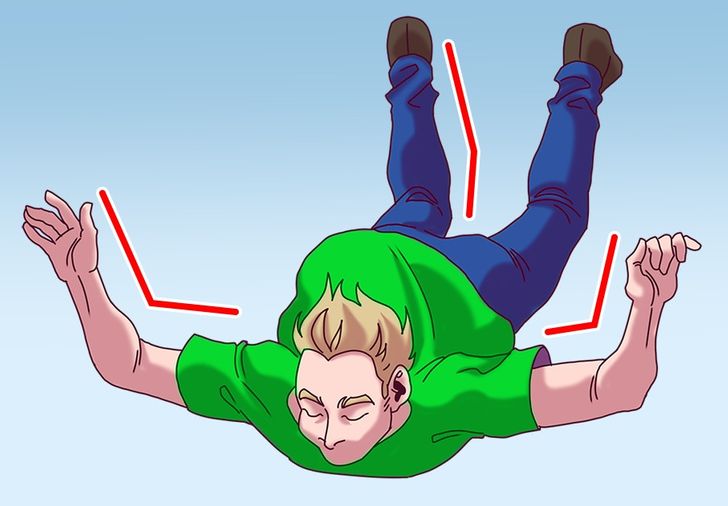
In case you fall from an extreme height, try to remember:
- Emulate a skydiver. Your chest and head should face down. Extend your arms and legs and bend them at a 90-degree angle.
- Find a spot to land. It could be haystacks and bushes that can work as a cushion. Water is only safe if your fall is from around 150 feet high or less.
-
Get your body into a vertical position to hit the ground. It’s better to fall forward than backward.
-
Protect your head with your arms locked together.
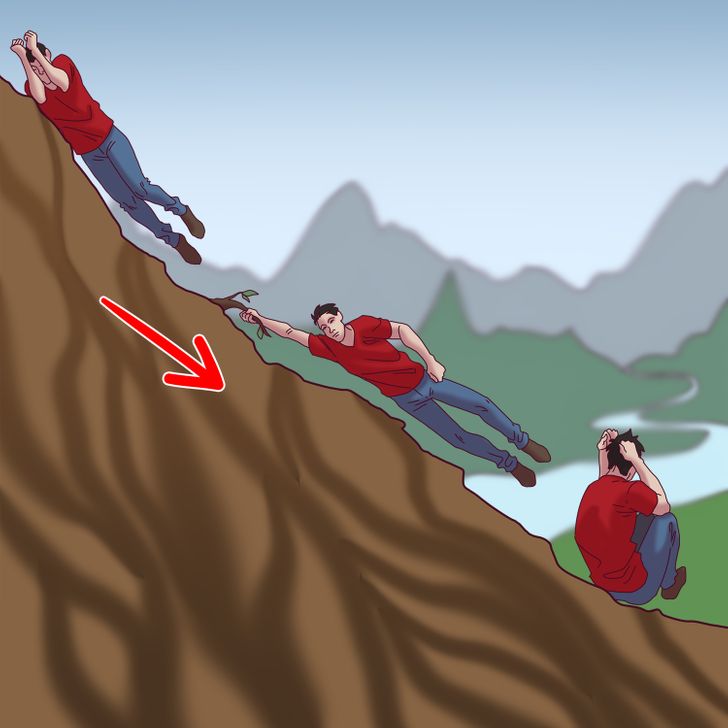
If you’re falling down from a mountain or a slope, these little tips may help you to avoid serious injuries.
- Divide your fall into parts by hitting a cliff or a tree. Grab objects on your way that are attached to the mountain.
- Don’t hold your body stiff because it can be harmful to your internal organs.
- Protect the head with your hands locked together.
- Land on your feet with your knees slightly bent.
- Land on the balls of your feet, so your body has a chance to absorb the impact more effectively.
- Avoid falling on your back. Instead, try to do it on your side.
3. How to survive a lightning strike
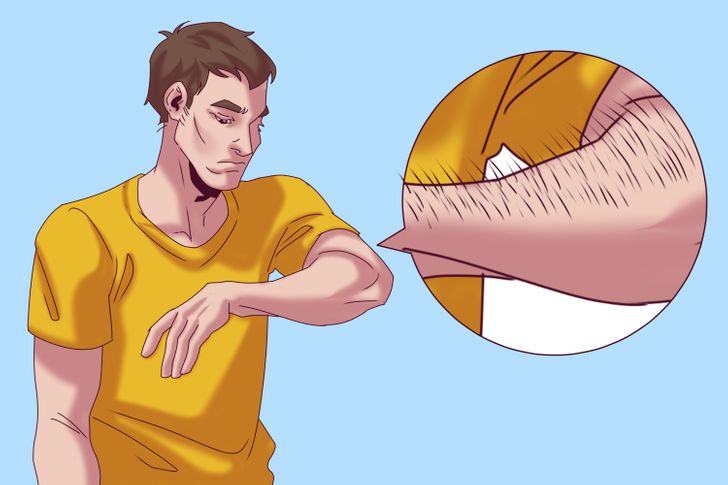
- Pay attention to your body’s sensations when you’re outside. Before the lighting strike, you can feel the hair on your body stand on end. Your skin might tingle and you will probably hear a buzzing or clicking sound.
- Crouch down like a baseball catcher and put your head between your knees. Try to be as low as you can, but never lie down.
- Place your hands over your ears to minimize hearing loss.
- The only thing that should touch the ground should be the balls of your feet.
- Put the heels of your feet together so electricity can go in one foot and out the other, instead of your body.
4. How to survive in the desert
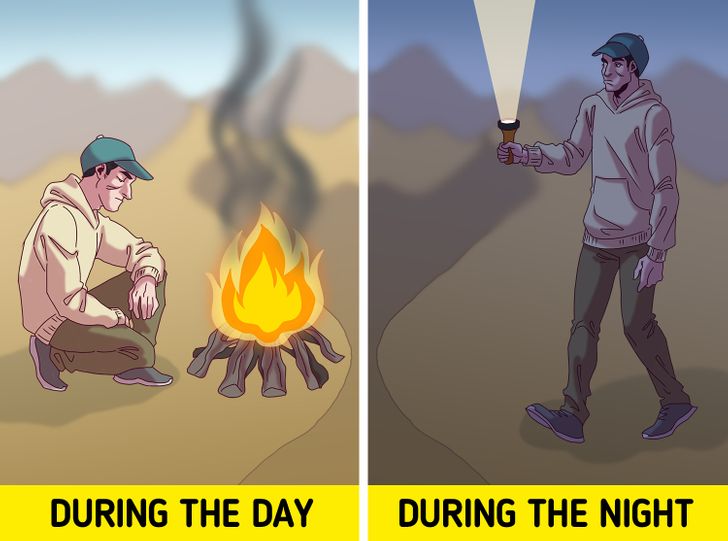
If you’re stuck in the desert, having a survival tactic is crucial.
- Don’t move during the day. Pick the cooler night to travel long distances in order to save the water in your body.
- Stay in the shade during the day. You can make a shelter with any type of material you can find.
- Send help signals. Create smoke during the day and light at night.
- Find a water source. Follow the animals and birds, find the greenest vegetation, look for a slope of hard, non-porous rocks. You will probably find rainwater there.
- If you feel exhausted, don’t walk any further, but have a couple of sips of water (if you have it) and take a rest.
- Stay away from spiny plants. You can injure yourself and get infected.
5. How to survive in the woods
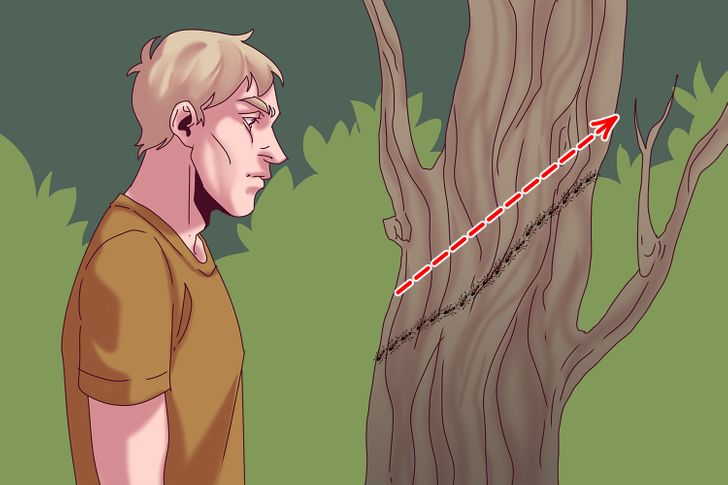
- First of all, search for water. Try to check low-lying areas where water could be collected and near any animal tracks you see. If there are mountains, look for water at the foot of the cliffs.
- If you’ve collected rainwater, don’t let it stay in a container too long because bacteria can contaminate it. Purify any water you have, if possible.
- Follow ants climbing trees. If you see ants on trees, there’s a chance they’re traveling toward a source of moisture inside the tree. If you find it, wring the water right into your mouth.
But, be careful not to swallow any ants.
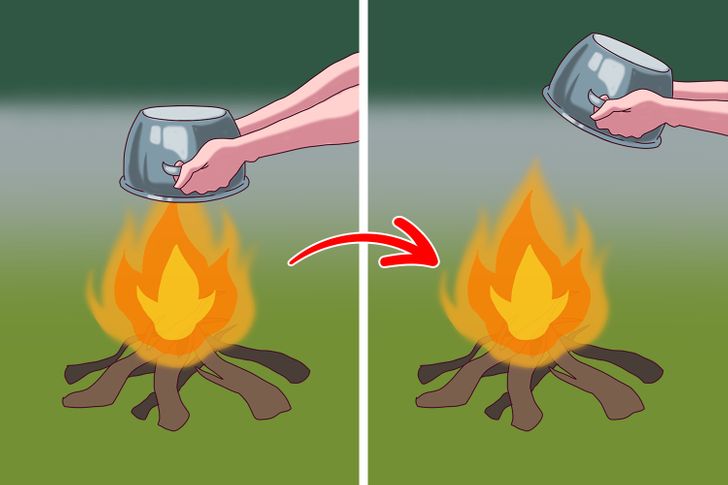
4. Start a fire. Find small, dry material like leaves and large and small branches. Build a teepee with it. Use a flat piece of wood and scrape a small groove into the center of it. With another branch start rubbing the center until you create fire. Light up your teepee structure.
5. Use fire and smoke to send signals of help. Cover the fire with a big branch or with any pan for 3-4 seconds to collect enough smoke. Then let this puff of smoke go.
6. How to survive while drowning
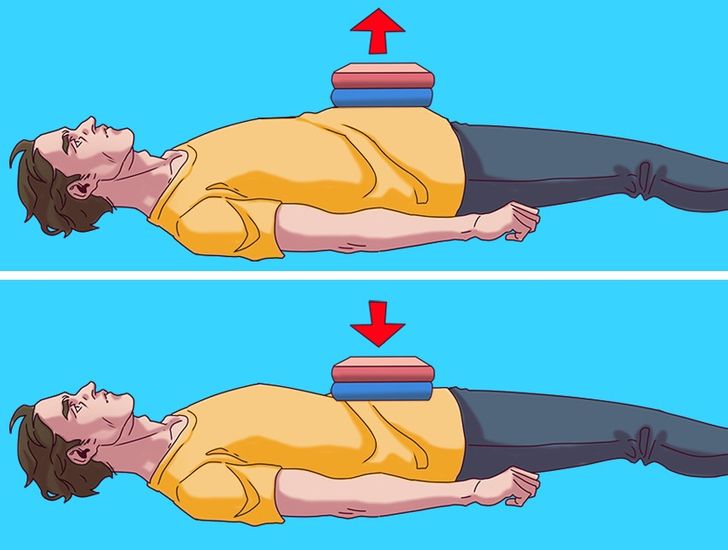
When you stay underwater for a long time, you need to be able to hold your breath. In this case, you can practice diaphragmatic exercises that can help you to survive. Try this exercise that can also help you to get rid of poor breathing habits in your everyday life:
- Get a stack of books. They shouldn’t be heavy.
- Lie down on the floor and place these books on your belly.
- Inhale slowly into your belly. The books should move up as a sign of correctly inhaling.
- Exhale slowly. The books should go down. Do this exercise several times.
You can also try holding your breath while swimming.
- Warm-up first, without holding your breath, while swimming 400 meters.
- Do 10 sets of 25-meter freestyle swims without breathing. Take 15-30 seconds breaks between sets.
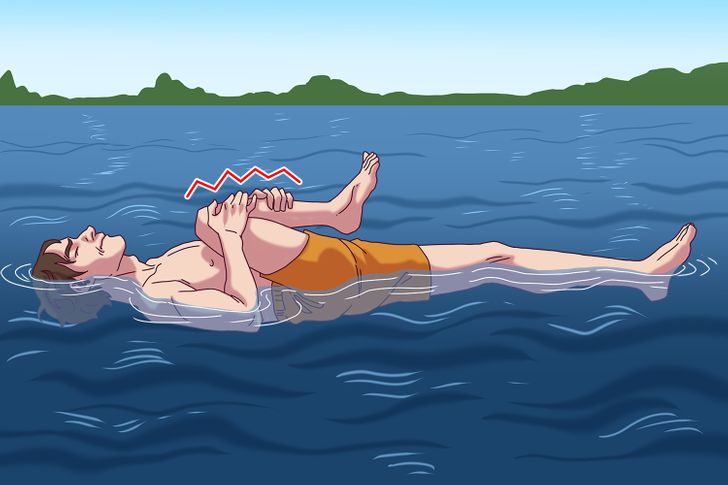
The best way to survive underwater is to avoid getting there in the first place. So, when you have a muscle cramp, do this:
- Make sure you get enough water before swimming because dehydration can cause cramps.
- Try to lie on your back and start floating. Massage the bottom of your foot or the part of your leg that is very tight.
- If you have a cramp on the back of your leg, bend your knee while floating on your back and start stretching your leg by pulling your toes toward you.
7. How to survive frostbite
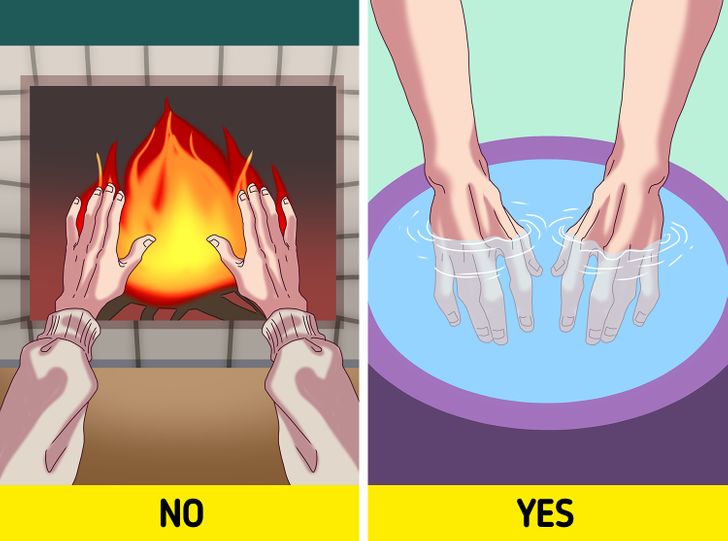
- Define the early signs of frostbite: waxy, white, and hard skin. You will feel a numb, burning sensation. Frostbite may affect children faster than adults.
- If you feel these sensations, don’t stay in the cold and search for professional medical treatment.
- Don’t use a hairdryer, heating pads, or a fireplace to warm up.
- Have something warm to drink, use blankets and soak the frostbitten area in water that is between 101°F to 104°F, until the skin turns pink.
-
After the skin turns pink, dry it very gently and wrap it in gauze bandages.
-
Put gauze bandages or cotton balls between the fingers or toes if they are injured.
-
Seek medical attention.
8. How to survive an ostrich attack
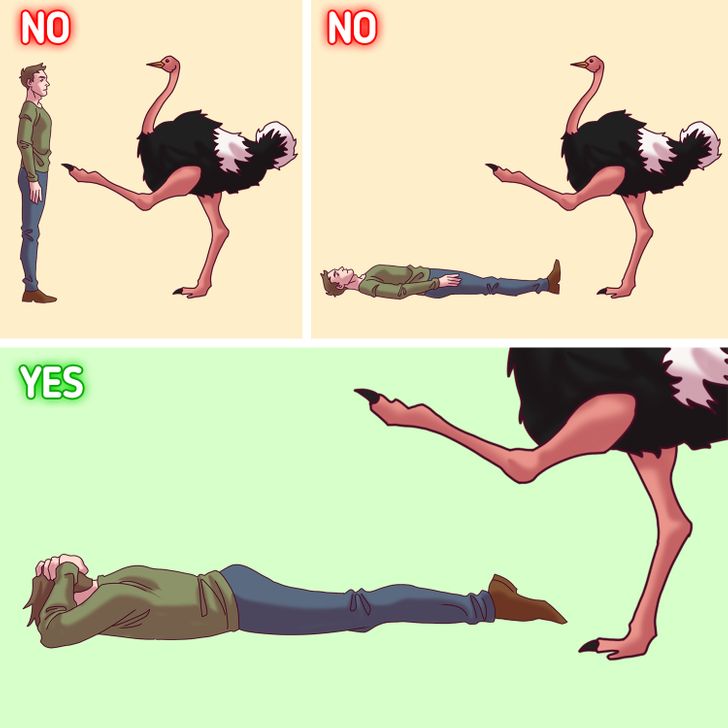
- The safest way to survive an ostrich attack is to take cover. Don’t try to run far from it because ostriches are very fast.
- If you can’t take cover, climb a tree.
- If there is no cover or if there are no trees, play dead. Lie with your face down and cover your head and neck with your hands. It’s always better than standing up or trying to outrun an ostrich.
What emergency situation have you experienced in your life? What tips helped you to survive it?
Comments
It's actually very weird but every time I walk on some bridge or stay on the balcony of a very tall building I think "what would happen to be if I fell from it? Would I survive?" Now I know how to survive :D
it's definitely weird because I think about such things too any time I look down from a high bridge
you just see your fears I guess
Yeah I don't like thinking about it though. I prefer to never fall like this
me too, but at least we know the tips :)))
Related Reads
16 Photos That Don’t Need Photoshop to Grab Your Attention

12 Unexpected but Fantastic Uses for Toothpaste You Never Knew Existed

15 Then and Now Photos That Can Open Your Eyes to the Power of Change

I Discovered the Shocking Reason My Fiancé Decided to Marry Me

15 Eerie True Events That Break Every Rule of Reason

I Spent Years Saving for an Engagement Ring, and It Vanished Without a Trace

My Daughter-in-Law’s Shocking Reaction to My Holiday Weight Comment Still Haunts Me

Top 20 Hottest Female Celebrities Over 50, According to 55k People

My Husband Is Playing a Series of Dangerous Pranks on Me — I’m Scared of Being Near Him

“Looks Unreal,” Demi Moore Stuns in a Sheer Dress at 61 and Shocks Fans

I Demand That My Stepdaughter Pays Us Rent — Her Dad’s House Is Not a Free Hotel

I Refused to Split My Son’s Inheritance With My Other Son
